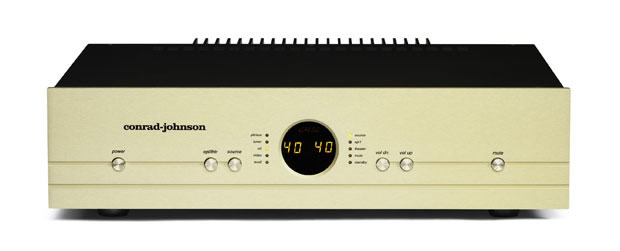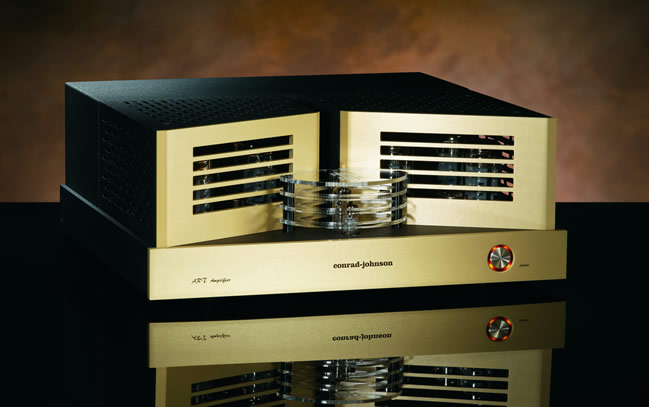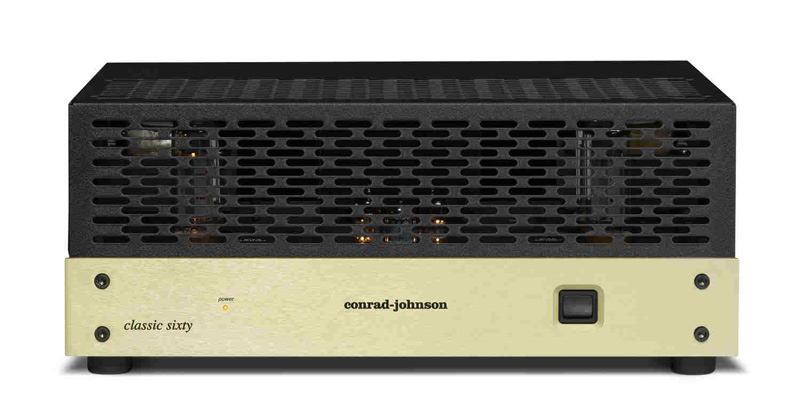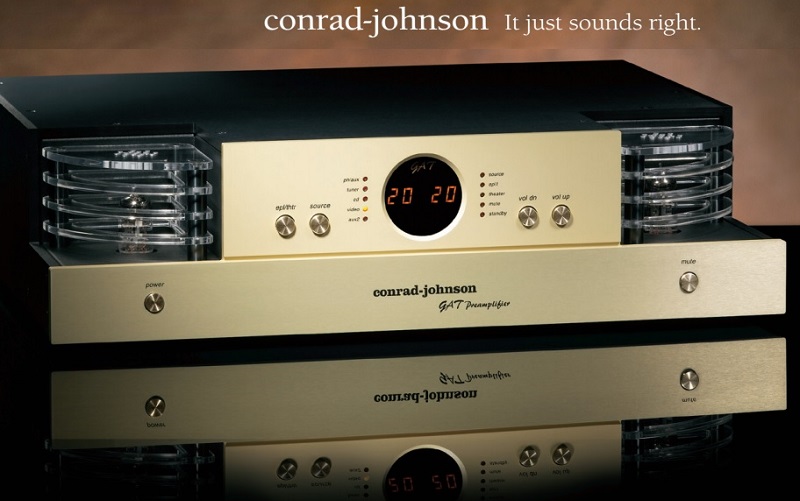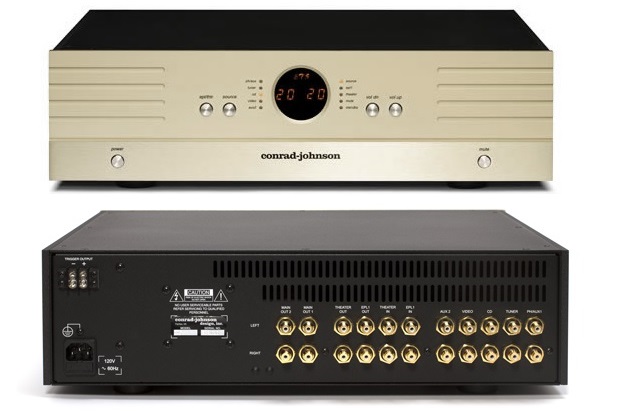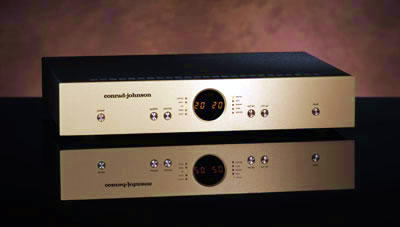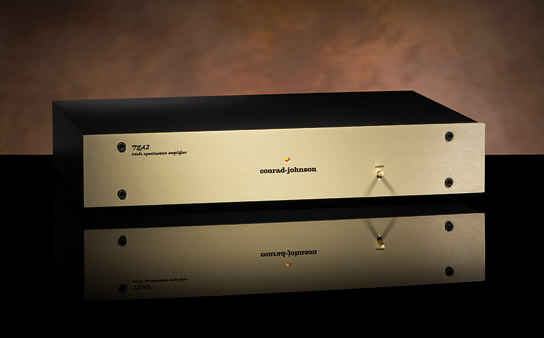Conrad Johnson
For more than thirty years, conrad-johnson has refined the concept of
high end audio through its relentless pursuit of excellence. For as long
as the company has been producing its world-renowned state of the art
audio instruments, it has also been adapting the technologies and
construction techniques responsible for those products and applying them
to more affordable components designed for the music-lover who requires
musically satisfying performance but whose budget does not encompass
the loftiest of current offerings.
Announcing the New CA150 Control Amplifier
Conrad-Johnson is pleased to announce the availability of the new conrad-johnson CA150 control amplifier – a power amplifier with level control and source selectors. A control amplifier is identical in function to an integrated amplifier, but without the additional distortions that would be inherent in a superfluous line-stage. Like an integrated amplifier, a control amplifier also eliminates the colorations of preamplifier to amplifier interconnect cables. The CA150 combines the circuitry of our popular MF2275 power amplifier with source selector circuits and a Burr-Brown precision level control.
With full remote control of all functions, and 7 line level inputs, including an EPL (tape) loop and Theater loop, the CA150 offers all the flexibility of our separate line-stage preamplifiers. And with rated output of 135 watts/channel, the CA150 has ample power for the majority of speaker systems.
ART and ARTsa Vacuum-Tube Power Amplifiers

The limited edition
ART Amplifier is designed to be a reference amplifier for the use of
industry professionals as well as dedicated audiophiles. Like its
companion GAT Preamplifier, the ART Amplifier will be offered in an
edition of just 250 units (125 pairs) to be sold through selected
conrad-johnson dealers and distributors. Those who do not need the
prodigious 275 watt power delivered by the mighty ART mono-blocks will
want to consider the ARTsa Stereo Amplifier. Nearly identical
cosmetically (one more tube in the front), it is exactly an ART
amplifier divided into two channels, each producing a solid 140 watts.
At conrad-johnson, our approach to circuit design is predicated on the principle that the surest path to both state-of-the-art musicality and exceptional reliability is simple circuits constructed of the finest available parts. These ART amplifiers exemplify this basic principle. The audio circuit has just three elements, each as simple as possible, and each essential to the operation of the amplifier. A voltage gain amplifier (a single triode) is direct-coupled to a cathode coupled phase inverter (each phase handled by a single triode), which in turn drives the output stage. For the ART mono-blocks, four pairs of KT120 output tubes, chosen for their musical accuracy, high power, and reliability, endow this amplifier with a muscular 275 watt output rating. For the ARTsa, two pairs of KT120 output tubes in each channel produce 140 watts of power per channel. A small amount (about 12 dB) of loop negative feedback reduces distortion and achieves a sufficiently high damping factor to control the reactive load typically presented by high-performance loudspeaker systems. To assure continued peak performance, the owner need only make a simple bias adjustment when new tubes are installed. Built in LED bias indicators allow the user to make this adjustment using only the supplied screwdriver.
Separate, low impedance, discrete dc power supply regulators are provided for the input and phase-inverter stages, thoroughly isolating these stages from the power demands of the output stage. These power supplies are designed to maintain a rock solid supply at all audio frequencies.
Component parts contribute importantly to the sonic performance of any circuit design. The ART amplifiers maintain the exacting quality standards for which conrad-johnson is internationally known. Resistors are precision laser-trimmed metal foil types. Coupling capacitors are the new Teflon CJD caps, while the power supplies use large value polypropylene capacitors in parallel with CJD Teflons. There are no electrolytic capacitors in the audio circuits or in the related power supplies. Proprietary wide-bandwidth output transformers contribute to excellent high frequency performance. Even the machined gold plated OFC connectors and the internal wiring have been carefully selected for optimal sonic performance. Attention to every detail enable us to extract the full potential from our circuit designs and ensures that our products will perform to this potential for years to come. The ART and ARTsa amplifiers are built without compromise to achieve a new standard in musical performance, and they are built to last.
At conrad-johnson, our approach to circuit design is predicated on the principle that the surest path to both state-of-the-art musicality and exceptional reliability is simple circuits constructed of the finest available parts. These ART amplifiers exemplify this basic principle. The audio circuit has just three elements, each as simple as possible, and each essential to the operation of the amplifier. A voltage gain amplifier (a single triode) is direct-coupled to a cathode coupled phase inverter (each phase handled by a single triode), which in turn drives the output stage. For the ART mono-blocks, four pairs of KT120 output tubes, chosen for their musical accuracy, high power, and reliability, endow this amplifier with a muscular 275 watt output rating. For the ARTsa, two pairs of KT120 output tubes in each channel produce 140 watts of power per channel. A small amount (about 12 dB) of loop negative feedback reduces distortion and achieves a sufficiently high damping factor to control the reactive load typically presented by high-performance loudspeaker systems. To assure continued peak performance, the owner need only make a simple bias adjustment when new tubes are installed. Built in LED bias indicators allow the user to make this adjustment using only the supplied screwdriver.
Separate, low impedance, discrete dc power supply regulators are provided for the input and phase-inverter stages, thoroughly isolating these stages from the power demands of the output stage. These power supplies are designed to maintain a rock solid supply at all audio frequencies.
Component parts contribute importantly to the sonic performance of any circuit design. The ART amplifiers maintain the exacting quality standards for which conrad-johnson is internationally known. Resistors are precision laser-trimmed metal foil types. Coupling capacitors are the new Teflon CJD caps, while the power supplies use large value polypropylene capacitors in parallel with CJD Teflons. There are no electrolytic capacitors in the audio circuits or in the related power supplies. Proprietary wide-bandwidth output transformers contribute to excellent high frequency performance. Even the machined gold plated OFC connectors and the internal wiring have been carefully selected for optimal sonic performance. Attention to every detail enable us to extract the full potential from our circuit designs and ensures that our products will perform to this potential for years to come. The ART and ARTsa amplifiers are built without compromise to achieve a new standard in musical performance, and they are built to last.
LP125sa Vacuum-Tube Stereo Power Amplifier
The LP125sa Stereo
Amplifier and LP260m mono-block are the latest in the highly regarded
series of conrad-johnson vacuum-tube power amplifiers. The LP125sa
offers a compelling combination of the audio excellence one expects from
conrad-johnson, the convenience of a single stereo chassis, and, at 125
watts per channel, sufficient power for the majority of high-end
speaker systems. Those with more demanding speaker systems will want to
turn to the LP260m mono-block powerhouse, rated at 270 watts. Both
amplifiers are capable of capturing the delicate textures and subtle
nuances of live music while maintaining control with the authority that
comes with ample power.
Nearly identical in
both models, the audio circuit consists of three stages. The input
signal is amplified by a single-ended triode amplifier designed for wide
band width. The signal is then direct coupled to a cathode coupled
phase-inverter. This high cur rent, triode phase-inverter stage provides
a bal anced, low impedance drive to the output stage. Output power is
developed by KT120 power tubes (two pairs per channel in the LP125sa,
four pairs in the LP260m), chosen for their excellent sonic character,
high power capability, and reliability. The output tubes are operated in
ultralinear configuration which offers a desir able combination of high
power and low distortion. Massive output transformers with intricately
interleaved wind ings afford extended bandpass and high phase
linearity. A small amount (about 12 dB) of loop negative feedback
reduces distortion and achieves a sufficiently high damping factor to
control reactive loudspeaker systems.
Power supply design is every bit as critical to the performance of an audio component as the audio circuit itself. Separate, low impedance, discrete dc power supply regulators are provided for the input and phase-inverter stages, preventing the output stage from modulating these stages through the power supply.
These amplifiers require no complicated adjustments or specialized equipment to main tain. To assure continued peak performance, the owner need only make a simple bias adjustment when new tubes are installed. Built in LED bias indicators allow the user to make this adjustment using only the supplied bias adjustment tool.
Power supply design is every bit as critical to the performance of an audio component as the audio circuit itself. Separate, low impedance, discrete dc power supply regulators are provided for the input and phase-inverter stages, preventing the output stage from modulating these stages through the power supply.
These amplifiers require no complicated adjustments or specialized equipment to main tain. To assure continued peak performance, the owner need only make a simple bias adjustment when new tubes are installed. Built in LED bias indicators allow the user to make this adjustment using only the supplied bias adjustment tool.
LP260M Vacuum-Tube Mono Power Amplifier
At conrad-johnson we
are keenly aware that component parts contribute importantly to the
sonic performance of any circuit design. As expected for conrad-johnson
products, the LP125sa and LP260m amplifiers set uncommonly high quality
standards. Resistors are precision metal film types. All audio-circuit
capacitors, as well as all capacitors in the regulated power supplies
are polypropylene and polystyrene. Proprietary wide-bandwidth output
transformers contribute to excellent high frequency performance. Even
the gold plated connectors and the internal wiring have been carefully
selected for optimal sonic performance. These amplifiers offer tube
performance that "just sounds right". Those who wish to take the
experience a step further will want to investigate the upgraded LP125sa+
and LP260mSE which incorporate CJD Teflon Capacitors and ultra
high-performance metal foil resistors in strategic applications in the
circuit. Any of these models is sure to rekindle your passion for
enjoying great music in your home.
Classic Sixty Vacuum-Tube Amplifier
Tasked with developing the most cost effective amplifier that we could
build, consistent with our standards of quality of construction and
performance, the conrad-johnson design team turned to our flagship
product for inspiration. Borrowing heavily on the technology of its big
brother, the ART amplifier, the Classic Sixty preserves the
distinctive tonal character of individual instruments and voices, with
each clearly located within the overall acoustical environment of the
original recording. Musical transients are reproduced with realistic
impact, but without artificial enhancement. Like its more costly
siblings, the Classic Sixty captures the emotional impact of the live event, never getting between the listener and the musical performance.
There really is no mystery to the basis for outstanding musical performance: best results come from simple circuits executed with quality parts. The Classic Sixty
amplifier circuit design is about as simple as possible, employing just
seven vacuum-tubes. Single-ended triode voltage gain and inverter
stages are coupled to an output stage comprised of a single pair of
ultra-linear operated EL34 tubes for each channel. As it is critically
important that the DC voltage supplied to the gain stages be absolutely
rock-solid stable, these voltages are provided by simple but highly
effective discrete voltage regulators. And speaking of simple,
maintenance of the Classic Sixty could hardly be easier: the
owner need only make a simple bias adjustment using the built in bias
indicators when installing fresh output tubes.
The use of premium quality component parts is the other half of our underlying design mandate. In this area as well, the Classic Sixty is a leader in its class. Precision, metal-film resistors yield low noise performance for greatest clarity. Polypropylene and polystyrene capacitors, chosen to achieve a high degree of temporal accuracy, are specified for both the audio circuits and the regulated plate voltage supplies for the input and inverter stages. The result is an exceptional range of dynamics – reproducing both subtle variations in level as well as dramatic loud crescendos. Our proprietary trans-spectral wide-bandwidth output transformers contribute importantly to the extended, "airy" highs that help distinguish the Classic Sixty from ordinary tubed amplifiers.
The use of premium quality component parts is the other half of our underlying design mandate. In this area as well, the Classic Sixty is a leader in its class. Precision, metal-film resistors yield low noise performance for greatest clarity. Polypropylene and polystyrene capacitors, chosen to achieve a high degree of temporal accuracy, are specified for both the audio circuits and the regulated plate voltage supplies for the input and inverter stages. The result is an exceptional range of dynamics – reproducing both subtle variations in level as well as dramatic loud crescendos. Our proprietary trans-spectral wide-bandwidth output transformers contribute importantly to the extended, "airy" highs that help distinguish the Classic Sixty from ordinary tubed amplifiers.
The Classic Sixty offers an ideal introduction to the joys of
modern tube amplifiers, while the ease of use, low maintenance costs,
and reliability will be a revelation for those who have only experienced
"entry-level" tube gear. Those who wish to take the experience a step
further will want to investigate the upgraded Classic Sixty SE,
which upgrades the output tubes to KT120s and incorporates CJD Teflon
Capacitors and ultra high-performance metal foil resistors in strategic
applications in the circuit. Either model is sure to rekindle your
passion for enjoying great music in your home.
Specifications:
Power: 60 Watts per channel vacuum-tube amplifier.
Frequency Response (at 10 watts): 20 Hz to 20 kHz, +/- .3 dB.
Tube Complement: 1 x 6189, 2 x 6922, 4 x KT120.
Dimensions: 13.25 D x 17.375 W x 6.625 H inches.
Weight: 41 Lbs.
Specifications:
Power: 60 Watts per channel vacuum-tube amplifier.
Frequency Response (at 10 watts): 20 Hz to 20 kHz, +/- .3 dB.
Tube Complement: 1 x 6189, 2 x 6922, 4 x KT120.
Dimensions: 13.25 D x 17.375 W x 6.625 H inches.
Weight: 41 Lbs.
MF2550 and MF2275 Solid-State Amplifiers
These latest solid-state amplifiers, the MF2550 and MF2275, nicely embody this
approach. Differing primarily in power output rating, these amplifiers share a
common circuit design. High voltage FETS permit highly linear operation of the
critical first voltage gain stage, while bi-polar transistors are
used to configure an output stage with low output impedance to deliver
maximum current to reactive speaker loads.
Linear operation of the audio circuit requires a power supply designed to maintain absolutely fixed operating voltages while meeting current demands that fluctuate rapidly with the music itself. This imposes on the power supply similar design and component choice requirements as on the audio circuit itself. These amplifiers feature discrete dc regulators to power the critical voltage gain stage. The power supplies and grounds for the input and output stages are run by separate power transformer windings to isolate the input stage from the effects of the substantial current flows required in the output stage.
Linear operation of the audio circuit requires a power supply designed to maintain absolutely fixed operating voltages while meeting current demands that fluctuate rapidly with the music itself. This imposes on the power supply similar design and component choice requirements as on the audio circuit itself. These amplifiers feature discrete dc regulators to power the critical voltage gain stage. The power supplies and grounds for the input and output stages are run by separate power transformer windings to isolate the input stage from the effects of the substantial current flows required in the output stage.
MF2275 Amplifiers
MF2275 Solid State Amplifiers specifications:
Power: 35 Watts per channel.
Frequency Response (at 10 Watts): 20 Hz to 20 kHz, +/- .1 dB.
Dimensions: 14.625 D x 19 W x 4.875 H inches, 33 lbs.
Power: 35 Watts per channel.
Frequency Response (at 10 Watts): 20 Hz to 20 kHz, +/- .1 dB.
Dimensions: 14.625 D x 19 W x 4.875 H inches, 33 lbs.
MF2550 Amplifiers
MF2550 Solid State Amplifiers specifications:
Power: 250 Watts per channel from 20 Hz to 20 KHz at no more than 1.0% THD.
Sensitivity: 2.0 Volts rms to rated power.
Frequency Response (at 10 Watts): 20 Hz to 20 kHz, +/- .1 dB.
Hum and Noise: 100 dB below rated power input. Impedance: 100 KOhms.
Dimensions: 16.25D x 19W x 6.125H inches, 52 lbs.
Power: 250 Watts per channel from 20 Hz to 20 KHz at no more than 1.0% THD.
Sensitivity: 2.0 Volts rms to rated power.
Frequency Response (at 10 Watts): 20 Hz to 20 kHz, +/- .1 dB.
Hum and Noise: 100 dB below rated power input. Impedance: 100 KOhms.
Dimensions: 16.25D x 19W x 6.125H inches, 52 lbs.
GAT Triode Preamplifier
The GAT
Preamplifier embodies conrad-johnson’s latest advances in line-stage
preamplifier technology. We believe that it will quickly be recognized
as the new industry-wide reference standard for line-stage preamplifier
performance, a role filled for more than a decade by its legendary
predecessor, the ART preamplifier. Like the ART, the GAT Preamplifier
will be available in a numbered, limited edition of 250 units which will
be sold through selected conrad-johnson dealers.
The GAT Preamplifier is a vacuum-tube, line-stage preamplifier that looks as good as it sounds. It is also notable for convenience and ease of use. The unit features input selection and level adjustment by microprocessor-controlled relays. Level and balance can be adjusted in 100 steps of approximately .7 dB per step. All functions can be controlled by the hand-held wireless remote control.
The GAT Preamplifier is a vacuum-tube, line-stage preamplifier that looks as good as it sounds. It is also notable for convenience and ease of use. The unit features input selection and level adjustment by microprocessor-controlled relays. Level and balance can be adjusted in 100 steps of approximately .7 dB per step. All functions can be controlled by the hand-held wireless remote control.
ET5 Enhanced Triode Preamplifier

Introduced in 2009,
the GAT Preamplifier continues conrad-johnson's dominant position atop
the rankings of reference preamplifiers. An important benefit of
pursuing state-of-the-art designs is that the circuits and techniques
developed in our flagship products are frequently directly applicable to
our entire line of products. In this instance, we have embodied the
technology of the GAT Preamplifier in the more cost effective ET5
enhance triode line-stage preamplifier at a more affordable price.
ET3 Vacuum-Tube Preamplifier
At conrad-johnson, development of our flagship products has
traditionally led to important enhancements of our entry-level
offerings.
The ET3 preamplifier is a case in point. The ET3 line-stage is a
“baby” version of our flagship line-stage preamplifier, the GAT. The
family resemblance is much more than skin deep. With voltage gain
provided by a triode vacuum-tube, the zero-feedback line-stage circuit
of the ET3, along with its DC voltage regulators, closely replicates the
circuit of the GAT. Finally, and especially noteworthy, the ET3
features a relay operated discrete stepped attenuator level-control
circuit of the type found in the GAT and CT5, absent only the balance
control function found in those more costly models.
Classic 2 & Classic 2 SE Preamplifiers
The conrad-johnson Classic-2 vacuum-tube preamplifier honors
this thirty-year heritage of musically accurate, moderately priced
preamplifiers which have displayed the conrad-johnson name.
The Classic-2 faithfully reproduces the harmonic structure of complex musical passages, preserving the distinctive tonal character of each instrument and voice. The space of the sound stage and the ambience of the concert hall are conveyed in realistic, three dimensional perspective. Individual instruments are precisely located within that three dimensional space. Musical transients are reproduced naturally, with realistic impact, but without the artificial enhancement which characterizes so many "hi-fi" components. Never imposing its own distractions, the Classic-2 invites the listener to enjoy the musical performance.
The Classic-2 faithfully reproduces the harmonic structure of complex musical passages, preserving the distinctive tonal character of each instrument and voice. The space of the sound stage and the ambience of the concert hall are conveyed in realistic, three dimensional perspective. Individual instruments are precisely located within that three dimensional space. Musical transients are reproduced naturally, with realistic impact, but without the artificial enhancement which characterizes so many "hi-fi" components. Never imposing its own distractions, the Classic-2 invites the listener to enjoy the musical performance.
TEA2 Phono Equalization Preamplifier
The TEA-2 triode equalization amplifier is a vacuum-tube phono stage
offering an extraordinary degree of musical accuracy at a moderate
price. The audio circuit of the TEA-2 is comprised of two cascaded
single-ended triode amplifiers. The circuit is a zero-feedback design,
to eliminate the temporal inaccuracies that negative feedback
introduces. RIAA equalization is established by a passive network
between the two gain stages. This network has been carefully designed
and has been implemented with precision (1% tolerance) parts to
precisely track the prescribed RIAA equalization curve assuring absolute
tonal accuracy. Careful implementation of this fundamentally simple
circuit results in extremely wide bandwidth, and low distortion, without
resorting to negative feedback. A high-current MOSFET buffer stage
follows the second gain stage to achieve a low output impedance (less
than 200 Ohms).
Specifications: Gain: Low Gain - 40 dB. High Gain - 55 dB. Overload: Low Gain - 175 mV High Gain - 50 mV. Hum and Noise: Direct Inputs - 80 dB below 10 mV input. Phase: phase correct. Ouput Impedance: below 200 ohms. Dimensions: 13.625"D x 19"W x 3.625"H. Net Weight: 14 lb.
Specifications: Gain: Low Gain - 40 dB. High Gain - 55 dB. Overload: Low Gain - 175 mV High Gain - 50 mV. Hum and Noise: Direct Inputs - 80 dB below 10 mV input. Phase: phase correct. Ouput Impedance: below 200 ohms. Dimensions: 13.625"D x 19"W x 3.625"H. Net Weight: 14 lb.
HD3 USB Digital to Analog Converter
The HD3 is an
audiophile grade digital to analog converter for use with a computer
based audio source. It is designed to exploit the advantages of the
recently available high-definition digital source material, to be simple
to use, and to establish that digital sources really can "just sound
right".
The HD3 is designed to be as hassle-free as possible. Connect it to any available USB port on your computer with a standard USB cable, select the HD3 and you should be ready to play music in a matter of moments. It is designed to work with the drivers built into the operating systems of all modern PC, Mac, and Linux computers, so there is no need to struggle with installing drivers as there are none to install. Just select your favorite tunes from music stored on your computer, or pop a CD into your computer's optical drive, sit back and enjoy.
The HD3 is designed to be as hassle-free as possible. Connect it to any available USB port on your computer with a standard USB cable, select the HD3 and you should be ready to play music in a matter of moments. It is designed to work with the drivers built into the operating systems of all modern PC, Mac, and Linux computers, so there is no need to struggle with installing drivers as there are none to install. Just select your favorite tunes from music stored on your computer, or pop a CD into your computer's optical drive, sit back and enjoy.
With its
asynchronous data interface virtually eliminating jitter, the HD3 will
transform your computer into a high-end CD player competitive with the
very best audiophile quality units on the market. But it will do much
more than that. By "ripping" your CDs to the computer you can take
advantage of software that makes multiple read passes to virtually
eliminate data errors, for superior playback. You can store an entire
music collection on the hard-drive of your computer, and use your choice
of "juke-box" software to search for and select the songs or albums you
want to play. Preserve your CDs from possible damage in handling by
copying them to your hard drive and putting them away in safe storage.
Imagine a couple of thousand or more CDs of music all contained in the
space of a small computer. Better yet, the HD3 is designed to deliver
better than CD quality material. It will decode up to 24 bit, 96k
samples/second music files. These files are available for purchase by
download from various on-line sources.
The conrad-johnson analog audio circuits are your assurance that the HD3 will deliver the full potential of these sources and in the end, the music playback will be musical. As expected from conrad-johnson, the circuits are simple and executed with quality parts. A high-end Burr-Brown delta-sigma dac was selected for the digital to analog conversion. This is the most musically satisfying 24/96 capable dac presently available. The analog signal is fed to our own audio circuits, executed with highest quality polypropylene capacitors and metal foil and metal film resistors. The digital circuits are powered by regenerating power from the USB connection itself, while the analog portion of the dac and the analog audio stage are powered by separate transformers feeding discrete dc voltage regulators, thus isolating the analog signal from noise imposed on the grounds and power supply legs of the digital circuits.
The conrad-johnson analog audio circuits are your assurance that the HD3 will deliver the full potential of these sources and in the end, the music playback will be musical. As expected from conrad-johnson, the circuits are simple and executed with quality parts. A high-end Burr-Brown delta-sigma dac was selected for the digital to analog conversion. This is the most musically satisfying 24/96 capable dac presently available. The analog signal is fed to our own audio circuits, executed with highest quality polypropylene capacitors and metal foil and metal film resistors. The digital circuits are powered by regenerating power from the USB connection itself, while the analog portion of the dac and the analog audio stage are powered by separate transformers feeding discrete dc voltage regulators, thus isolating the analog signal from noise imposed on the grounds and power supply legs of the digital circuits.
The Conrad-Johnson Story
In
the mid-seventies, two economists, friends and serious audiophiles -
Dr. William Conrad and Dr. Lewis Johnson - were highly dissatisfied
with the commercially available equipment of the time and were also
perplexed and challenged by the readily apparent sonic differences
among components in their own systems. What made these two classic tube
systems sound so different? Could the virtues of each be somehow
combined? Not content to merely speculate on such issues, conrad and
johnson decided to systematically investigate by eveloping and
refining a vacuum-tube preamplifier.
The
resulting conrad-johnson preamplifier was immediately recognized as a
state of the art contender and catapulted Conrad and Johnson into the
audio industry.
The most important legacy of conrad-johnson design's beginnings is the basic methodology which took shape in the course of the development of that first preamplifier. This methodology has enabled Conrad and Johnson to develop new products which have routinely been ranked among the most musically satisfying. Few other manufacturers have so consistently received such high praise for their products.
The most important legacy of conrad-johnson design's beginnings is the basic methodology which took shape in the course of the development of that first preamplifier. This methodology has enabled Conrad and Johnson to develop new products which have routinely been ranked among the most musically satisfying. Few other manufacturers have so consistently received such high praise for their products.


